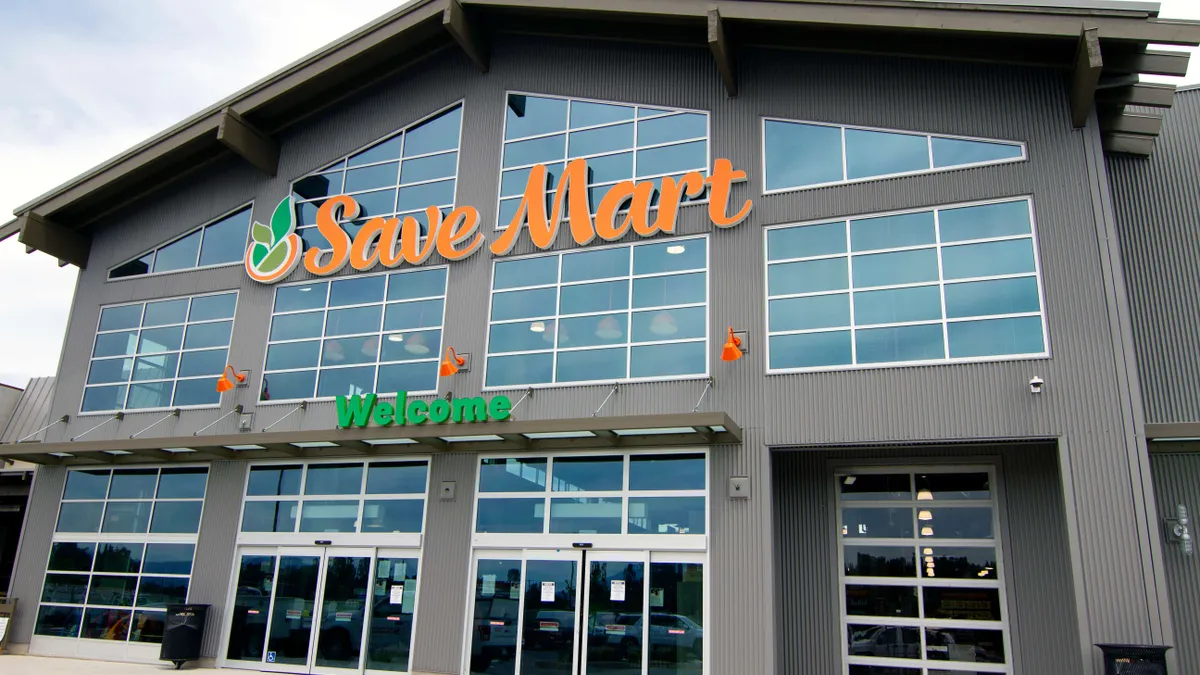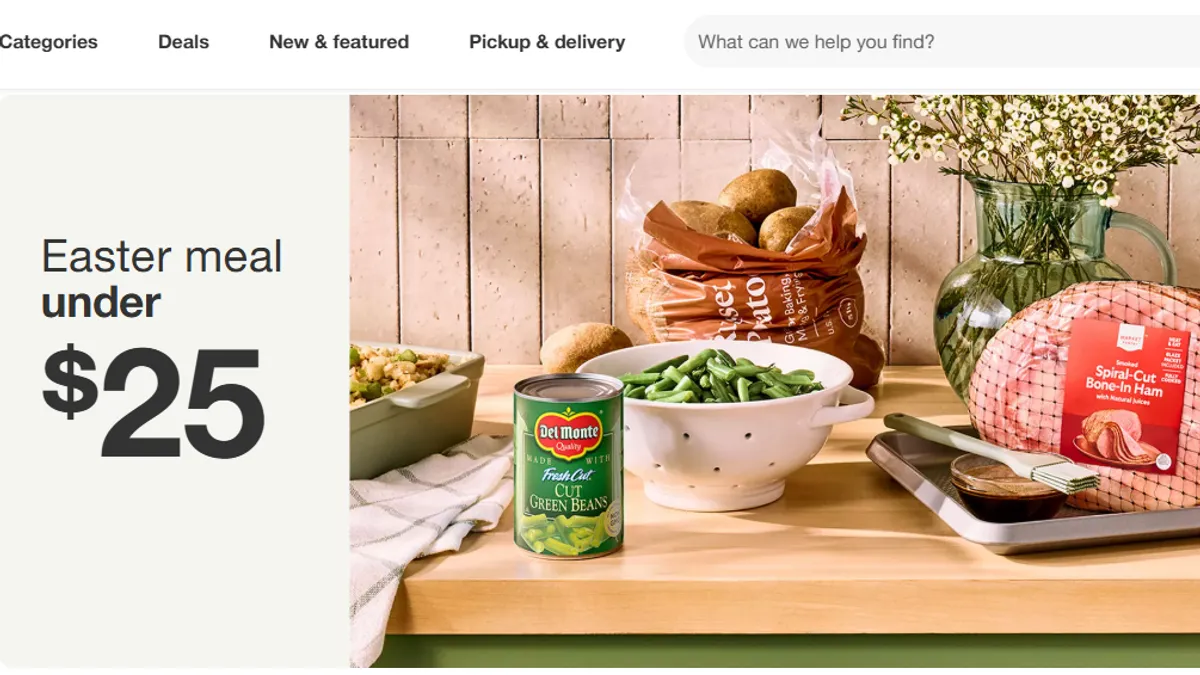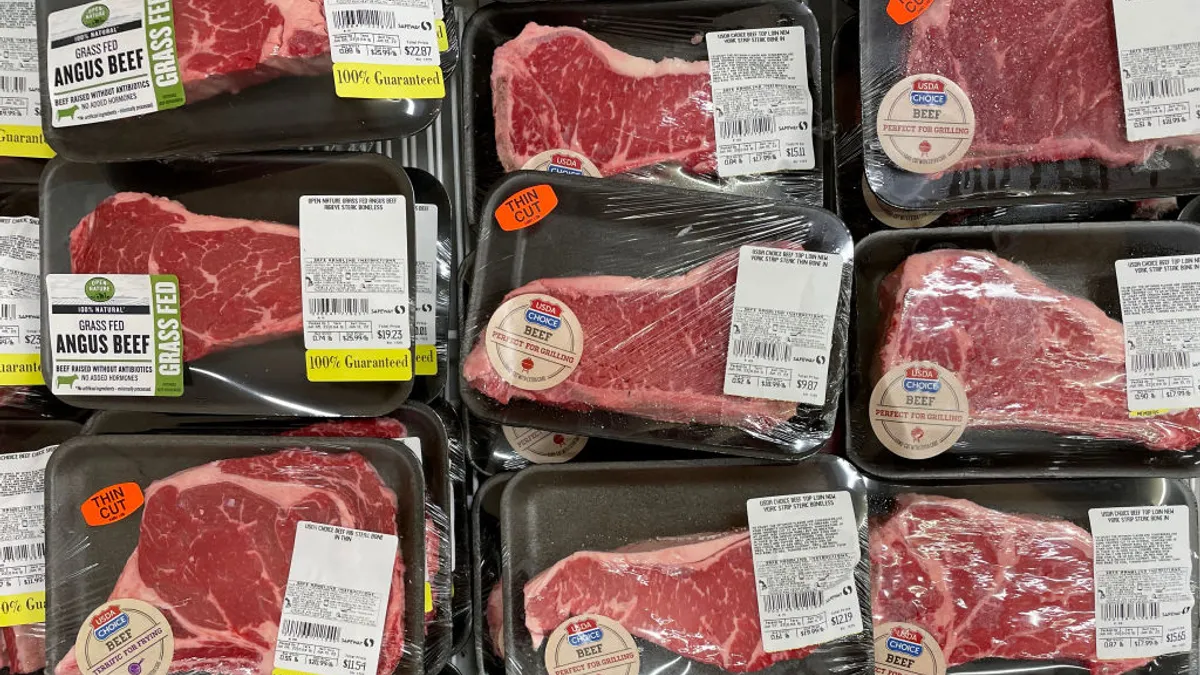A blustery, windy morning would cause many shoppers to abandon their trip to the grocery store and turn to the convenience of home delivery. But on Sunday, hundreds were willing to brave the damp conditions in Brooklyn — some waited for nearly seven hours in the dark — to step inside New York City's first Wegmans just before 7 a.m.
At the front of the line were the self-described "Women of Wegmans," a group of ladies dressed in pink Wegmans clothing who first met at an opening nine years ago in Virginia and have been to a dozen since then. Further back, there was Dave Alder, who left his home at 1 a.m. for a three-hour drive sporting his "Wegmans, people make it happen" T-shirt he wore when he worked at a store in the early '90s. And then there were people like Kimberly Ciaccia, who grew up with the supermarket chain and then missed it when she moved away.
People traveled from all across the country, including Wisconsin and Texas, to participate in the opening of the newest addition to a chain that has developed a cult-like following rare among grocery stores.
"I'm obsessed with Wegmans. It's literally the greatest place on earth. ... (My friends) think I'm crazy, but I believe they've never had a Wegmans," Emily Lobello, who lives in Albany, New York, told Grocery Dive. "It makes grocery shopping a very pleasant experience, (something that) I think a lot of people are always very negative about."
Christopher Doering
Inside the store, Kevin Cuff, the new manager and a 21-year Wegmans veteran, gave his workers a final pep talk.
"They said we couldn't open a store in Brooklyn. They said we couldn't find people in Brooklyn," he said. "To Wegmans employees, today is your day. Many of you trained for six, seven, eight months in New Jersey away from your families for this day, and it's here."
Moments later, the doors opened and people streamed into the store waving, smiling and giving their friends high fives. Several individuals had their arms stretched above their heads recording the moment on their phones. As the morning wore on the intensity of the rain outside increased, but curious new consumers and diehard Wegmans shoppers continued to funnel into the store. Cars could be seen circling the parking lot in search of a coveted spot.
A cult-like following
Wegmans has thrived with sprawling stores as large as 140,000-square foot — the size of nearly three football fields — in suburbs across the Northeast and Mid-Atlantic regions. But gradually, the retailer has been moving out of its comfort zone. It's been expanding south over the past few years, putting it in direct competition with other supermarkets such as the equally beloved Publix.
While Wegmans has succeeded in rolling out expansive new stores, replicating that success at its new 74,000-square-foot location in Brooklyn's Navy Yard is anything but certain and could prove to be the biggest test yet for the 103-year old grocer. If it succeeds here, analysts said the store could serve as a blueprint for Wegmans to enter other downtown areas such as Philadelphia, Cincinnati or even Chicago, all while further cementing the popular supermarket chain's ability to adapt to a rapidly changing food environment.
Founded in 1916 with a single produce wagon, the family-owned grocer has grown to 101 stores in seven states, and nearly half of those are located in New York State. Wegmans has thrived at a time when other supermarket chains have gone out of business or struggled to compete against Walmart, discounters like Aldi and Lidl and rising e-commerce player Amazon.
The economics of grocery remain challenged, with depressingly low margins that have squeezed the amount of money chains have to invest in their operations. But Wegmans has stood out, along with other regional retailers such as Iowa's Hy-Vee and H-E-B in Texas, as one of the prominent success stories and proof that supermarkets can prosper with the right formula of store experimentation, product mix, measured expansion and a loyal customer base.
"They’ve created a cult following even in markets that they're not in because of all the stories, because of people who had shopped there," Phil Lempert, founder and editor of SupermarketGuru.com, told Grocery Dive. "The stores are terrific. There’s no question about it."
Bill Bishop, a longtime grocery consultant and chief architect of Brick Meets Click, said Wegmans has distanced itself from its competitors by "really sweating the details" and prioritizing the customer experience before it was en vogue.
Bishop recalled a story: Robert Wegman, the son of the company's co-founder, was concerned that a traffic light at the company's first store near Washington, D.C., wasn't letting enough cars through during each cycle. Legend has it that he successfully got the light changed a few weeks later.
Something for everyone
Shoppers entering the Navy Yard Wegmans were greeted with full displays of cauliflower, broccoli, strawberries, lemons and sweet potatoes, among other produce. Store workers could be seen refilling displays for items such as Brussels sprouts and grapes throughout the morning even when there was plenty left to be sold.
Wegmans shoppers often champion the retailer's prepared food offerings, and the Navy Yard will deploy many of them. Just to the right of the store entrance, Wegmans cloistered together its coffee, made-to-order pizza shop (which offered slices for sale even at 7 a.m), a burger bar, custom-made salads, sushi, self-serve hot and cold food offerings with items such as craft beer barbecue wings and cauliflower and spinach gratin.
Nearby was a soup station and packaged grab-and-go entrees and sides with everything from lobster rolls and garlic parmesan tilapia to a 24-pack of deviled eggs, artichoke bruschetta chicken breasts and homestyle beef meatloaf. A second floor mezzanine with nearly 100 seats has a bar serving wine, cocktails and draught beer.
The Navy Yard store stocks a total of 50,000 items including more than 300 cheeses, hundreds of produce selections, 2,000 organic products, dozens of fresh baked items like cookies, donuts, muffins and water-boiled bagels, as well as breads and rolls made with grain grown near Wegmans stores — a feature that was prominently highlighted by the grocer in a store display.
The new location struggled with the usual first day growing pains. One customer asked for Boss Sauce, a sweet and sour condiment produced in Rochester, New York where Wegmans is headquartered. After an employee apologized that with a smaller store footprint the store carried fewer products, she promised to relay the request to management, noting that several other people asked for the item, too.
Navy Yard customers were using compact carts to navigate the store, bypassing the larger ones found in most stores. And Wegmans stocked surplus sparkling water, chips, Gatorade, Honey Nut Cheerios, granola bars and Fritos on top of shelves, often still housed in cardboard boxes or plastic wrap, all in an apparent bid to maximize space.
Risks of the unknown
Wegmans posted sales of $9.2 billion in 2018 across 98 stores, according to the company's website, including three locations that opened during the year. Compare that to grocery giant Kroger, with roughly 2,765 retail stores, which posted fiscal 2018 sales of $121.2 billion, and Albertsons whose revenue was $60.5 billion at about 2,270 locations. Ahold Delhaize, whose 2,000-plus U.S. stores are spread along the East Coast, had $44.2 billion domestically in sales in 2018.
Bishop estimated that sales at the average Wegmans — which are about two to three times the size of a typical grocery store — are about $2.5 million a week, nearly five times as much as the median total of $455,777 recorded by the typical supermarket in 2018, according to the Food Marketing Institute. With millions in revenue feeding what is likely a hugely profitable operation, Wegmans is able to test new ideas that other struggling retailers don't have the financial wherewithal or risk tolerance to make.
"(Wegmans) is a business that does operate well. It’s base is successful so it probably feels that it can take some risk in terms of doing slightly different things," Bishop said.
Still, the new store will have a series of challenges that Wegmans will need to overcome.
The grocer banks on its stores drawing shoppers from far and wide. With nearly 4 million people living within a six-mile radius of the The Admiral's Row development where the store sits, the numbers certainly look promising. But getting there via public transit — the preferred method of travel for more than half of all New York City dwellers — will test the brand's appeal.
The store is at least a 10-minute walk from nearby subway and ferry stations — a near-eternity for shoppers loaded up with groceries. Bus service cuts the walk down to three minutes, and the Navy Yard provides shuttle service from subway stops, but a multi-part journey could prove too challenging for customers coming from Manhattan, Queens and Brooklyn's surrounding neighborhoods.
The area around the new store is largely isolated with three vacant buildings abutting the grocer's parking lot with signs inviting prospective tenants to come "join Wegmans." A large public park lies just across the street from the store in one direction, while in another is a public housing project.
The easiest way to get to the store is by car, with 700 parking spots (mostly underground) available. However, less than half of New York City dwellers and just 22% of Manhattanites own their own vehicle, according to city data.
Ultimately, the onus will be on Wegmans to convince shoppers to come to its store and forgo their loyalty to a nearby retailer or bypass the convenience of home delivery.
"We have no idea what's going to happen," Danny Wegman, the company's chairman, told Bloomberg in April about the Navy Yard store. "But if you like people and you like food, that's what our business is. It's no more complicated than that." Wegmans declined to make executives available to Grocery Dive for an interview.
Wegmans also has to contend with a dynamic and fiercely competitive market that includes a popular e-commerce brand (FreshDirect), specialty stores (Trader Joe's and Whole Foods) and hundreds of beloved local markets.
"They have to do something spectacular with (Navy Yard) to break through everything that's there now. You can't just be a fabulous Wegmans. It has to be something even better."

Phil Lempert
Founder and editor, SupermarketGuru.com
Lempert said with home delivery being popular in the New York City area, Wegmans could consider doing its own grocery delivery at Navy Yard rather than using Instacart like it does at all its other stores. By keeping the service in-house, Wegmans could get groceries delivered faster in 30 minutes, besting Instacart's one-hour promise, and use the same delivery person when possible to establish deeper rapport with the customer. Wegmans is starting Instacart deliveries at Navy Yard Oct. 30.
Neil Saunders, managing director with Global Data, agreed that Navy Yard will be "a big challenge" for Wegmans because the shopping dynamics will be different than any store it has opened before. A smaller store, greater use of alternative transportation options and less driving could change what people purchase. Their buying also could shift from a larger stock-up trip to more frequent stops where they shop for a few days or even just grab a few items on their way home from work — a change that will force Wegmans to modify its product offerings compared to its traditional outlets.
But Saunders said he is confident that Wegmans "has the ingredients" to succeed in Brooklyn. Focusing on a new concept like city-based stores allows Wegmans to add another avenue for future growth, he noted. While the grocer still has plenty of room to expand within its existing markets, smaller urban formats will allow it to tap into underserved population-dense areas being increasingly targeted by retailers.
"Wegmans management is very much on the ball and is very much thinking about the future rather than just being satisfied with where they are," Saunders said. "And that inevitably is part of what makes Wegmans good, they do try to test new things. They don't sit back and become complacent."
Correction: A previous version of this story misstated the size of Wegmans' Brooklyn Navy Yard location. The store occupies 74,000 square feet.





















